Kerala: A state of multi-layered bipolar polity
The southern state has a uniquely multicultural society and there are entrenched pockets of support for various political actors in different parts of Kerala
If the Communist Party of India (Marxist) or CPI(M)-led Left Democratic Front (LDF) manages to secure a majority in the Kerala elections scheduled for April 6, it will create history. Kerala’s voters have rotated power between the LDF and the Congress-led United Democratic Front (UDF) since 1982. To be sure, Kerala is not the only state where political power changes hands regularly. Tamil Nadu had this tradition for 32 uninterrupted years, until J Jayalalithaa led the All India Anna Dravida Munnetra Kazhagam (AIADMK) to a consecutive victory in the 2016 elections. Rajasthan too has been electing a Congress and Bharatiya Janata Party (BJP) government in turn since 1993. In Karnataka, the Congress and BJP have won alternate assembly elections since 2004. To be sure, the BJP was the single largest party but failed to secure a majority of its own in the in 2018 elections.
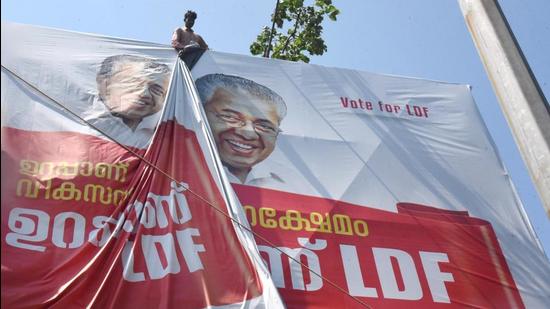
Also Read | Need third front in country, says NCP’s Sharad Pawar, welcomes PC Chacko
What makes Kerala’s polity unique is the fact that neither the CPI(M) nor the Congress, the leading parties of the two major political formations, enjoy the kind of political dominance which their counterparts (or units) in Tamil Nadu or Rajasthan do. An HT analysis shows that the reasons for this are to be found in the state’s uniquely multicultural society and entrenched pockets of support for various political actors in different parts of Kerala. Here are four charts which explain this in detail.
CPI(M) and Congress put together enjoy just around half of the total vote share
Even though the CPI(M) and the Congress are the dominant partners in the LDF and UDF, their combined vote share has hovered around the 50% mark in the state. This figure was 50.2% in the 2016 assembly elections. This is very different scenario from the other states discussed above. The combined vote share of two dominant parties is higher in these states than it has been in Kerala. In Tamil Nadu, the combined vote share of the two, AIADMK and the Dravida Munnetra Kazhagam (DMK) has been around the 60% mark since 1980. In Rajasthan, the combined vote share of the Congress and BJP has been 70%-80% since 1993.
Alliances are crucial in state elections, and larger parties exploit this in Lok Sabha elections
The reason why the combined vote share of the CPI(M) and the Congress is not very high in Kerala is that both the LDF and UDF have multiple alliance partners and both the LDF and UDF contest fewer seats. For example, the CPI(M) and the Congress contested just 60% and 62% of the 140 assembly constituencies (ACs) in the state in the 2016 elections. The LDF and UDF had seven and five alliance partners in 2016.
Alliances matter in Kerala elections. Unlike in Tamil Nadu, where the two major parties DMK and AIADMK perform better against alliance partners than each other, both the CPI(M) and the Congress are equally vulnerable to losing against smaller allies as well.
These alliances work for both the CPI(M) and the Congress in Lok Sabha elections, where they contest a much larger share of seats. In the 2019 Lok Sabha elections, they contested 70% and 80% of the Lok Sabha seats respectively. This shows that there is a clear quid-pro-quo between the smaller and bigger parties in the state where the former get their share in the assembly in return for supporting their bigger allies in the Lok Sabha.
Reading alliances with Kerala’s religious equations
Kerala’s religious composition is unique in the country. While Hindus comprise the majority, their overall share in population is just 55%, which is significantly less than the all-India average and the second lowest among India’s major states after Punjab. Muslims and Christians have a share of 27% and 18% in the state’s population. All these shares are taken from the 2011 census.
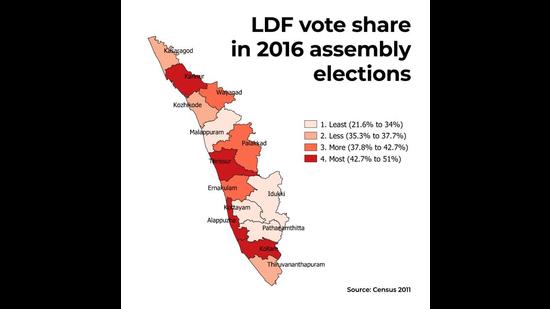
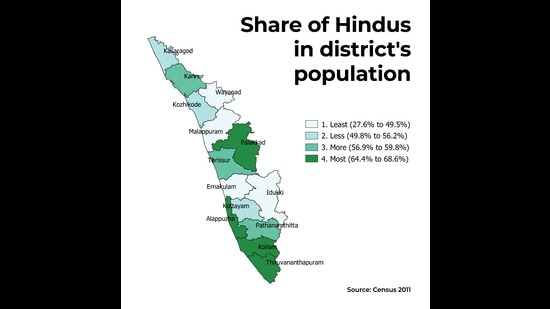
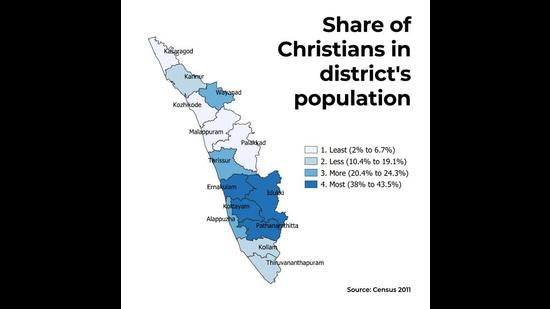
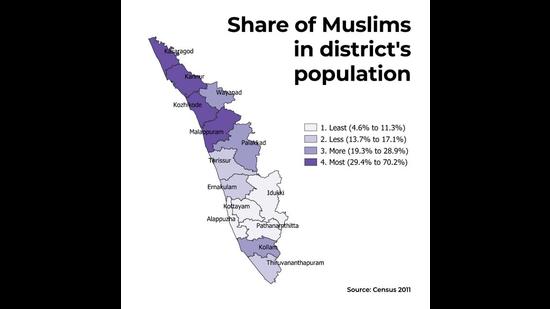
There is remarkable intra-state diversity in the state’s religious population as well. Of the 14 districts in the state, three districts in North Kerala; Malappuram, Kozhikode and Kasargod have the highest share of Muslims, while the Christians are a concentrated in central Kerala in districts such as Kottayam, Idukki, Pathanamthitta and Ernakulam. The Hindu population is the highest in the southern districts of the state.
A district-wise analysis of the 2016 elections shows that the LDF had a higher vote share in the Hindu dominated districts while the UDF had an edge in regions where the Muslim and Christian population was higher. While the BJP is still a marginal player in the state in terms of vote share, its presence is mainly concentrated in the Hindu majority districts.



